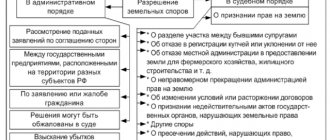Home / Real estate / Land / Ownership / Forms of ownership
Back
Published: 06/07/2017
Reading time: 11 min
0
674
Land ownership is one of the main economic and legal categories in Russian legislation. Land can belong not only to citizens privately, but also to the state as a whole. The features of state lands will be discussed further in the article.
- What is state ownership of land and what areas does it apply to?
- Types of state lands Federal property
- Regional property
- Municipal property
What is state ownership of land and what areas does it apply to?
As can be seen from the very name of this category, this is the state’s ownership of land plots, owned by state and municipal bodies.
State ownership of land is divided into several levels of government; this will be discussed in detail later in the article.
In general terms, we can say that state ownership extends to all those land plots that have not been transferred into private ownership by citizens or organizations.
In addition, there is the concept of lands that are withdrawn from circulation and limited in circulation. Due to their special status, they cannot be transferred into “private hands” and therefore belong strictly to the state.
The basis for the emergence of private property rights to land
The emergence of basic private property rights takes into account the Civil Code of the Russian Federation. This regulatory legal act contains the key parameters of such a transaction, which are manifested in the form of:
- Concluding a transaction for the purchase and sale of lands for agricultural, horticultural, gardening and other purposes. These can also be transactions of donation of a land plot, its exchange or alienation, after which the procedure for terminating the rights of one of the subjects of legal relations occurs (Article 218 of the Civil Code of the Russian Federation).
- Inheritance of private property, as well as succession of land or reorganization of a legal entity that used the target lands, including agricultural ones.
- Privatization, which is one of the most popular grounds for the emergence of private property rights today. In this case, the procedure for terminating municipal or state property with a transition to the category of private property is carried out in accordance with Art. 217 Civil Code of the Russian Federation.
- Other grounds provided for by modern legislation of the Russian Federation, including acquisitive prescription (this ground does not apply to agricultural land).
Types of public lands
Due to the fact that our entire state is divided into constituent entities of the Russian Federation, and each subject into municipalities, ownership of land plots was also divided according to this principle.
Lists of lands assigned to three levels of government are contained in the Land Code of the Russian Federation.
Each type of property will be discussed below.
Federal property
This includes the following lands:
- areas on which buildings (or structures) are erected that are owned by federal authorities and their structures;
- land plots provided to government agencies and their representative offices, as well as state-owned enterprises, for the implementation of their activities;
- plots of land that are permanently used by the Academies of Sciences and its divisions (this rule applies if the land was transferred before the acts regulating the activities of such institutions came into force);
- territories of land leased to the Russian Highways enterprise by an authorized authority.
Regional property
This type of ownership arises if land plots are transferred from a higher level to the disposal of the authorities of the corresponding subject of the Russian Federation.
These may be the following types of plots.
- Those lands on which real estate objects are located, owned by regional authorities on the right of ownership.
- Territories transferred from the federal level to the constituent entities of the Russian Federation, since enterprises or non-profit organizations formed at the regional level are located on them.
- Land plots that are classified as agricultural lands.
- Areas occupied by roads, communications and plantings, as well as water bodies in order to protect them from negative impacts. This rule does not apply to those lands that have the same status, but are already privately owned by individuals, or by federations or municipalities.
Land can also be transferred from federal ownership to the ownership of federal cities. There are three of them in the country: Moscow, St. Petersburg and Sevastopol.
Such transfer is carried out on the basis of both regional and federal norms, since the status of such lands is of a border nature.
Municipal property
Due to the fact that the municipal branch of government does not belong to the state branch and exists, so to speak, separately from everyone else, it is assigned its own lands. This right of municipalities is undeniable; it is established by special laws.
When delineating state ownership of land objects, the following areas fall under the control of local authorities:
- on which there are buildings (or structures) owned by municipalities;
- those transferred to local authorities, municipal enterprises or non-profit structures created at the municipal level.
Grounds for the emergence of state ownership of land
Such grounds are regulated by Articles 17 and 18 of the Land Code of the Russian Federation, that is, the right of federal or regional property arises:
- by virtue of federal law;
- as a result of the delimitation of state ownership of land;
- when a state body at the federal level or at the level of a constituent entity of the Russian Federation carries out a civil transaction under which the land plot was transferred into state ownership.
Grounds for the emergence of land ownership
Each plot registered as the property of an individual or legal entity has title documentation, which is also defined as title documentation. Read all the details about title and title documentation here.
Ownership of a land plot arises from the moment of receipt of this primary document, which the owner receives at the time of transfer of rights to the land plot in his favor. The designated document indicates the civil action that provided the land into the ownership of the person indicated in the documentation.
Among such actions that allow citizens to take possession of land (the grounds for the emergence of rights to land plots), the following can be identified:
- property transactions: purchase and sale, gift or exchange.
- Inherited property transferred from a deceased owner to a legal successor by will or by law in order of priority (you can find out the owner by cadastral number here).
- Privatization of municipal or state lands.
As a result of the indicated forms of transfer of rights, a transfer of ownership occurs from one owner (the transferor of the property) to another (the legal successor).
Subjects and objects of state ownership of land
u_note note_color=”#E9F8ED”]
Subjects of any property right, whether private or public, are the corresponding authorized persons who can own, use and dispose of their plots of land.[/su_note]
In addition, they must have signs of legal capacity.
In the case of state property, the subjects are:
- Russian Federation as a whole;
- each individual subject of the country.
It is the disposal of land plots that is carried out by state and regional authorities, which are endowed with similar powers by laws and other legal acts.
As for state property, as already mentioned, for each level there are separate types of land that can be owned by authorities at the federal and regional levels.
In addition, each plot that is an object of state property must have the following parameters:
- Individual characteristics. This includes information such as cadastral number, location, as well as certain boundaries, area, intended purpose and type of permitted use.
- Qualitative characteristics of the land plot or its share.
- Cadastral valuation – that is, the value of the plot according to the cadastre.
- Turnover (the site should not be limited in turnover or withdrawn from circulation).
- Divisibility, that is, the plot must have the ability to be divided into several new land objects.
State ownership of land and its types
The right of state property means that the powers of ownership, use and disposal belong to the state. The state, as a subject of state property rights, is represented not by one department, but by a number of different government bodies, between which property rights are distributed.
Taking into account the federal structure of Russia and the existence of two levels of state power, it is stipulated that the right of state property exists in the form of :
- federal property;
- property of the constituent entities of the Russian Federation (so-called subject or regional).
Object of state ownership of land:
- lands that are not owned by citizens, legal entities and municipalities (Article 214 of the Civil Code of the Russian Federation, Article 16 of the Land Code of the Russian Federation).
It is provided that the management of federal and subject property is carried out respectively by state authorities of the Russian Federation (Article 71 of the Constitution) and by the constituent entities of the Russian Federation.
The state (represented by the Russian Federation and its constituent entities) in land relations can act as:
- subject of state power, establishing the norms of land legislation, exercising state control over the use of land and other functions named in Art. 9 and 10 of the Land Code;
- owner of land plots - in the latter case, it enjoys the same rights and bears the same responsibilities as other owners of land plots.
In accordance with Art. 124 of the Civil Code of the Russian Federation, when concluding transactions with land and in other relations regulated by civil law, the Russian Federation and its subjects act on an equal footing with other participants in these relations - citizens and legal entities.
This is important to know: Benefits for pensioners on property and land taxes 2021
State ownership of land has a complex composition: it includes
- land plots owned by the Russian Federation (federal property), and
- land plots owned by constituent entities of the Russian Federation - republics, territories, regions, federal cities, autonomous regions, autonomous districts (property of the constituent entity of the Russian Federation).
On behalf of the Russian Federation and the constituent entities of the Russian Federation, the rights of the owner are exercised by government bodies within the limits of their competence established by acts defining the status of these bodies.
In cases and in the manner provided for by federal laws, decrees of the President of the Russian Federation and decrees of the Government of the Russian Federation, normative acts of the constituent entities of the Russian Federation, on their special instructions, state bodies, local government bodies, as well as legal entities and citizens can act on their behalf (Art. 125 of the Civil Code of the Russian Federation).
The Russian Federation and its constituent entities manage and dispose of land plots in their ownership. Such plots are directly owned and used by legal entities and citizens, to whom state-owned land plots are granted for use, lifelong inheritable possession and lease.
How land plots are formed from state-owned lands
Land plots classified as state or municipal property may become objects for the formation of new plots.
The formation of a new plot can be done in several ways:
- combining several plots of land into one;
- division of one land area into several new plots;
- allocation of a new land plot (for municipal lands).
The procedure for the formation of a new plot of land can only begin in connection with the adoption of a resolution of a regional or local government authority.
In addition, without a land surveying project, the following areas cannot be formed:
- from lands owned by organizations on a non-commercial basis;
- land plots that citizens have enjoyed for a long time on the right of lifelong inheritable ownership (transferred by order of the administration);
- from the lands included in the areas for residential development;
- from those lands that are located within the built-up area.
In addition to the land surveying project, other documents are also required to form a new land plot from state lands. For example, title documents, information about the site from the Unified State Register of Real Estate in the form of an extract, etc.
Without the procedure of land surveying and cadastral work, the formation of a new site is impossible.
After carrying out boundary work and drawing up the final document, which reflects the boundaries of the new land plot, data about it are entered by Rosreestr into the Unified State Register of Real Estate.
Find out what establishing the boundaries of a land plot is and why it is carried out. All the information you need about land surveying is in the article. The cadastral passport and everything connected with it is in our material.








